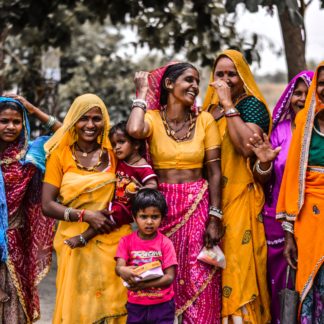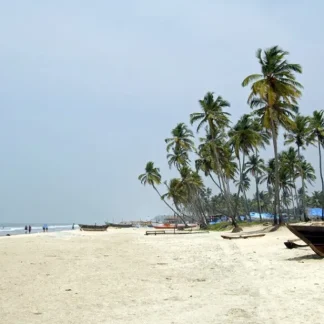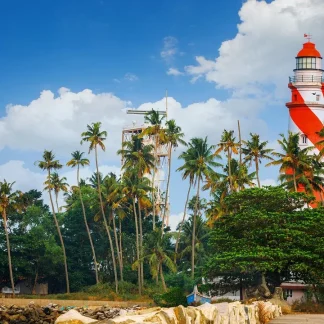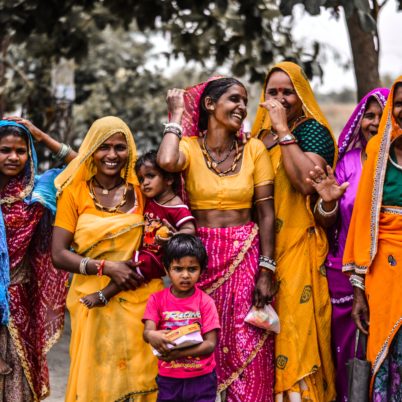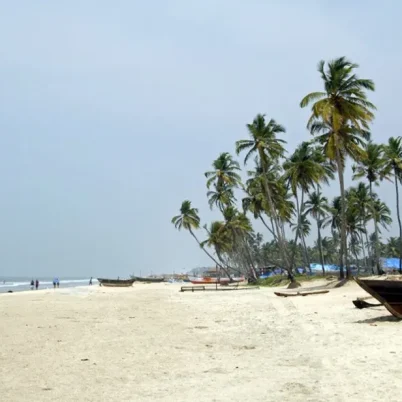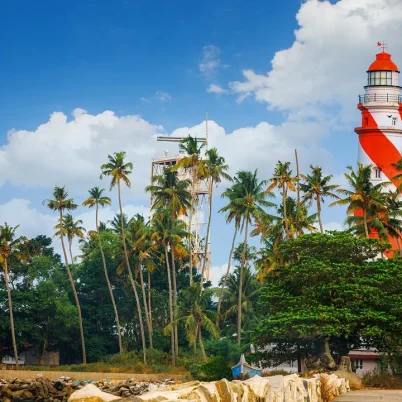
More dreams are realized and extinguished in Bombay than any other place in India – Gregory David Roberts
Mumbai, Bombay, or the city of dreams, the bustling metropolis on the west coast of India has many names. Named by the Portuguese Bom Bahia, meaning the good bay, the English pronounced the name as Bombay.
The government changed the name officially in 1996 to Mumbai, named after the local deity Mumba Devi. The city is the home of around 20 million people, the economic and commercial centre of the country, and always worth a visit!
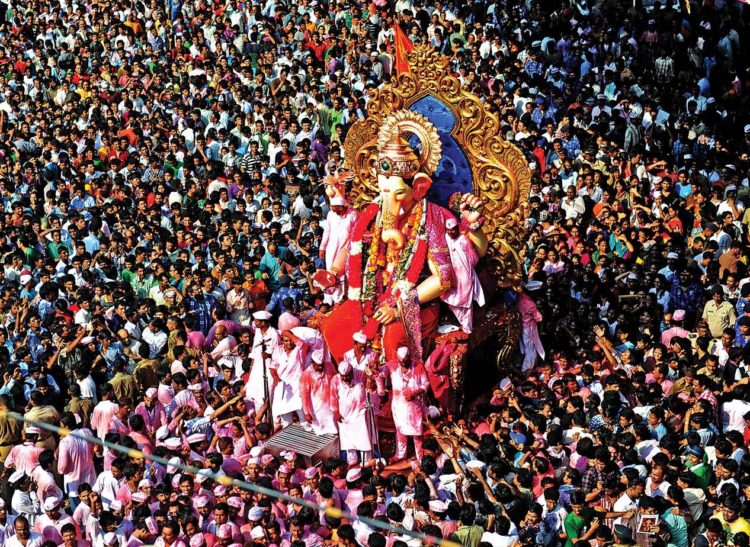
Here is a list of the top things to do in Mumbai:
1. Gateway of India
This unofficial icon of Mumbai has a historic significance for the whole country. Opposite of the Taj Mahal palace you will find yourself in front of a triumphal arc facing the sea which is dotted with all kinds of boats.
You can enjoy the views of the Gateway, the Taj Mahal Hotel and the beautiful Mumbai coastline by taking a ride in the ferry! Tickets are available at the counter, located a couple of metres away from the entrance to the monument.
These ferries are subject to weather conditions, especially in Monsoon (July-September) the services are halted when it rains!
VISITING HOURS: All-day, Ferry rides – 09:00 to 17:00 hours
ESTIMATED TIME: 15-30 mins
COST: Free, Ferry ride cost INR 110 per person.
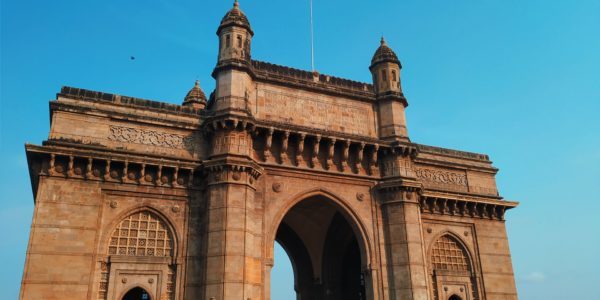
2. Taj Mahal Palace Hotel MUMBAI
The iconic luxury hotel with a sea view in Colaba represents the wealth of the city. Built-in 1903 by the industrialist Tata after he was denied access to some European hotels in the area, the Taj is an inherent part of Mumbai’s identity.
Right opposite of the Gateway of India, this iconic hotel has hosted every one of distinction in the last century, amongst them freedom fighters during the struggle for independence, rock stars, queens and kings.
If you are not a guest at the hotel, don’t hesitate to take a glance inside! You can easily enter the hotel and have a look around the luxurious lobby, grab a bite in one of the various restaurants.
Right across the entrance, you can also have a look at the small monument, which has the names of the armed forces who sacrificed their lives in the 2008 terrorist attack engraved on them.
VISITING HOURS: All days
ESTIMATED TIME: 15-20 mins
COST: Free
Read More: Luxury Hotels in India

3. Kala Ghoda
Kala Ghoda is the city’s art district with small lanes with numerous museums, art galleries, boutiques, cafes and restaurants. To name only a few of the prestigious cultural institutions: Chhatrapati Shivaji Maharaj Vastu Sangrahalaya or Prince of Wales Museum, Jehangir Art Gallery, DAG, Gallery MMB and Method Art Space.
The greatest highlight is the Kala Ghoda Art Festival, an annual week-long event in February which represents the spirit of the area. If you are in town make sure you drop by and enjoy all the events and shows. Another fascinating sight is the Keneseth-Eliyahoo-Synagogue which is still used by the decreasing Jewish community.
You can not miss it since it is a beautifully restored and maintained blue and white building. The tiny streets surrounding this place are lined with a variety of cafès and eateries if you wish to grab a quick bite!
VISITING HOURS: 10:00 to 17:30 hours
ESTIMATED TIME: 20-40 mins
4. Sassoon Dock MUMBAI
An adventurous early-morning highlight in Colaba is the Sassoon Dock, north of the Gateway of India. An impressive gate leads you to one of the oldest docks in Mumbai which was built in 1875 by the Jewish merchant Sassoon.
From around 5 am you can witness a fascinating spectacle. The before empty and dark dock now transforms into a bustling fish market. The Koli fishermen (actually the original inhabitants of the coast of Maharashtra) unload their catch and eager buyers from high ranking restaurants and local stalls are already waiting to make a good catch themselves.
The Bombil fish might be the celebrity amongst the various kinds of fish because it is used for the famous dish ‘Bombay Duck’. An unbelievable 20 tons of fish are sold in auctions on the dock itself every day, and you will see a wide variety of them being transported and sold if you wander to take a look.
VISITING HOURS: All days from 05:00 – 09:30 hours
ESTIMATED TIME: 15-30 mins
COST: Free
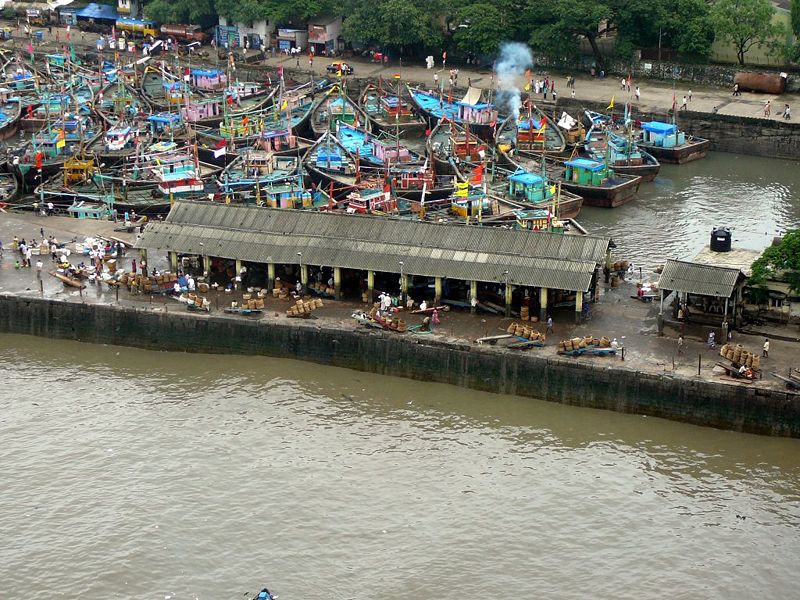
5. Asiatic Library & Horniman Circle
Located right next to the cathedral, is the garden of ‘Horniman Circle’. Although rather simple and small, it stands as an icon representing an important part of Mumbai history. It is considered the birthplace of Mumbai city, as it was the first and only trading post for cotton and opium traders in its time, two major trades which paved the way for the city’s development to an important finance and trade capital it is today!
You can simply walk through the centre of the garden, and exit on the other side. As you stand at the exit, right across the street, you will see the tall majestic white building of the Asiatic Society. An impressive neo-classical structure, this is actually the Town Hall of Bombay, that houses the Asiatic Society and Library, which forms part of the network of institutions created by the British.
The exterior is rather beautiful, a pure white structure against the blue skies, towering Doric columns (actually made in Great Britain and later transported and erected in Mumbai) and rows of steps leading up to the library! If you are here in the evening, you can sit on the steps and relax, a favourite activity of locals!
VISITING HOURS: Asiatic Library: All days, Horniman Circle Garden: 10:00-19:00 hours
ESTIMATED TIME: 15-20 mins
COST: Free
6. Bombay Stock Exchange & St. Thomas Cathedral
Established in 1875, the BSE (Bombay Stock Exchange) is Asia’s oldest stock exchange and currently the world’s 10th largest stock exchange! It was founded by Premchand Roychand, an influential.
The first location of the earliest stockbroker meetings in the 1850s was in a much more natural setting — under banyan trees — in front of the Town Hall, where Horniman Circle is now situated. In 1874, the brokers found a permanent location, aptly named Dalal Street (Brokers’ Street).
As you walk to the end of the street, you will pass the beautiful St. Thomas Cathedral The oldest Anglican church in Mumbai (about 300 years old).
This famous cathedral was once considered the ‘zero-point’ in the city. Meaning that it was located at the exact centre of the old city. The inside of the cathedral is as beautiful as the outside, if not more so!
With its beautiful paintings on glass by the windows, intricately designed altar and a beautiful fountain by the entrance, this place echoes rich history.
VISITING HOURS: BSE: All days, St.Thomas Cathedral: 07:00-18:00 hours
ESTIMATED TIME: 20-40 mins
COST: Free
7. Victoria’s Terminus/Chatrapati Shivaji Maharaj Terminus
This historic train station is situated in the heart of the city, representing India’s colonial past. Inaugurated in 1887 on the day of the Queen of England’s Jubilee it was named after this very Queen – Victoria Terminus. More than 100 years later it was renamed to Chhatrapati Shivaji Terminus (short CST).
The impressive architectural structure represents a Victorian-Gothic style, probably the most important in Mumbai. You will find Hindu and Islamic stylistics which resemble those of ancient Indian Palaces. For architecture lovers, the CST has a lot of small details to discover.
The view from the other side of the street is magnificent, especially at night when the building is beautifully illuminated. It definitely deserves the title of UNESCO World Heritage.
If you wish to venture inside and check out the train station, please make sure to buy a ‘platform ticket’ (available at the ticket counter on the right side of the entrance) which costs about INR 10 per person.
VISITING HOURS: All-day
ESTIMATED TIME: 20-40 mins
COST: Free
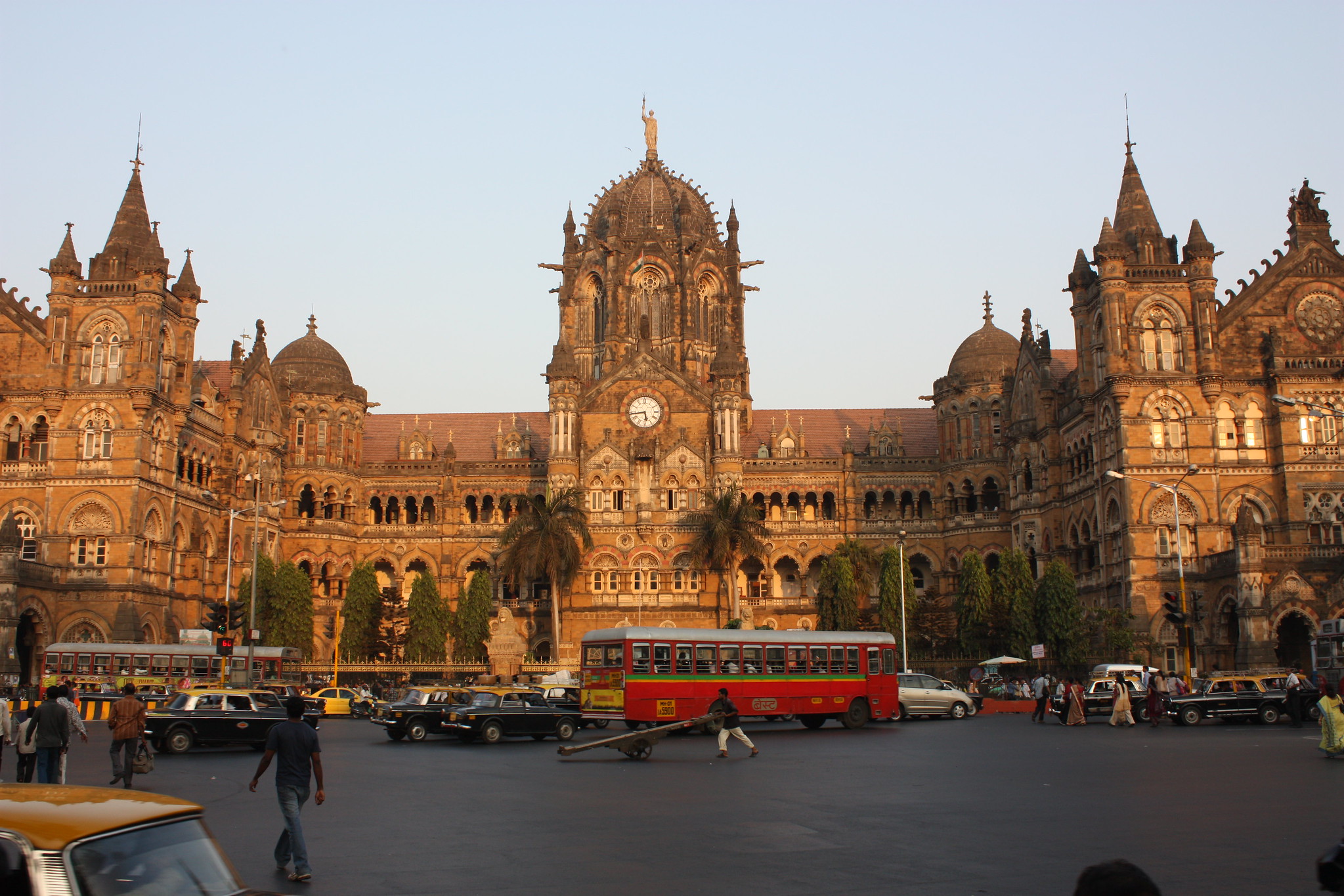
8. Marine Drive
You cannot understate what the stretch of Marine Drive means to locals. It is a beautiful promenade along the sea, with a beautiful view of the coastline! In the evening, when the street lights are turned on, the stretch looks bejewelled, earning the name ‘The Queen’s Necklace’.
Simply walk along the promenade, especially in the evening when it is cooler and you can experience the sunset over the sea. Lined along the coastline are beautiful art dèco buildings to see!
VISITING HOURS: All days
ESTIMATED TIME: 30 mins – 1 hour
COST: Free

9. Dhobi Ghat Mumbai
Located right next to the entrance of Mahalaxmi Railway Station on the Western Line, is a special platform created just to have a view over the Dhobi Ghat, where you will see clothes hanging on the wires above, small homes, old stone cubicles and modern-day machinery that are part of the daily life of washermen and their families who live here.
If you wish to see the intricacies of how this business works and a peek into the daily lives and activities of the people, it is recommended to get a local guide! Which should cost around INR 500 for a 20-minute English tour through Dhobi Ghat, explaining all the fascinating history and functioning of this 150-year-old business!
VISITING HOURS: All days (recommended early morning/afternoon)
ESTIMATED TIME:10-20 mins
COST: Free
10. Dabbawala (Tiffin Service System)
Any extent of modern technology will never be a match for the iconic Dabbawalas and their 125-year-old tiffin/lunchbox delivering system.
To watch them in action you can either be present at 11:30 hours across the main entrance of Churchgate Station (Google Maps) or inside CST Station/Victorias Terminus near the local railway platform. This is where the boxes are unloaded and sorted. There are about 5000 Dabbawalas delivering about 200,000 lunchboxes every day!
These boxes are collected from homes, restaurants or tiffin-making services by the Dabbawalas. Then are transported by bicycle and train to Churchgate & CST. This is because a vast majority of workers (corporate and labour) are located in the South Mumbai area.
These boxes are further sorted based on area and are transported to each individual/office! Most Dabbawalas are illiterate and have received little formal education.
So how do they manage such a seamless logistical process, which has the chances of making one mistake in 8 million deliveries? They create colour codes and symbols on each ‘Dabba’ (tiffin) which identifies location, destination, recipient etc. Furthermore, train timings are also calculated well in advance, so that pick-ups and deliveries take place punctually!
VISITING HOURS: 11:30-12:15 hours
ESTIMATED TIME: 10-15 minutes
COST: Free
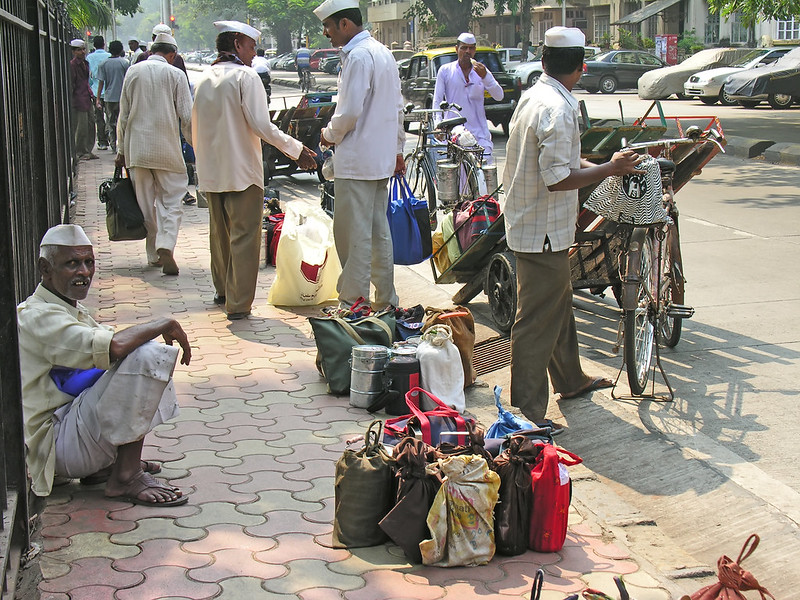
11. Elephanta Caves
On the small island of Gharapuri close to the Mumbai Harbour, you will find an impressive archaeological site with temples cut out of the rock. They are dated back to 450 A.D. to 750 A.D.
The impressive reliefs full of Hindu symbols made the island a UNESCO World Heritage site. You don’t need to hire an expensive guide here. At every corner you find small books which explain all the carvings in detail to give you an insight into the rich history of this small island
Once you reach the island you will have to climb a steep way up to the caves for around 30 mins. To make this exhausting walk enjoyable shops with tonnes of souvenirs are aligned along the way.
If you take the ferry ride to the caves a little after lunch (around 13:00-14:00 hours) you will get to experience the sunset and the beautiful skyline of Mumbai on your return journey.
VISITING HOURS: 09:00-15:30 hours (closed on Mondays and July to September)
Please note, 09:00 hrs is the timing of the departure of the first ferry and 15:30 is the departure time for the last ferry of the day from Gateway of India to Elephanta Caves
ESTIMATED TIME: 4-5 hours (1 hour for the ferry ride each way)
COST: INR 145-180 per person for the ferry ride, INR 10 to sit on the deck of the ferry, Indian INR 30 and foreigner INR 500 per person (entry fees for the caves)
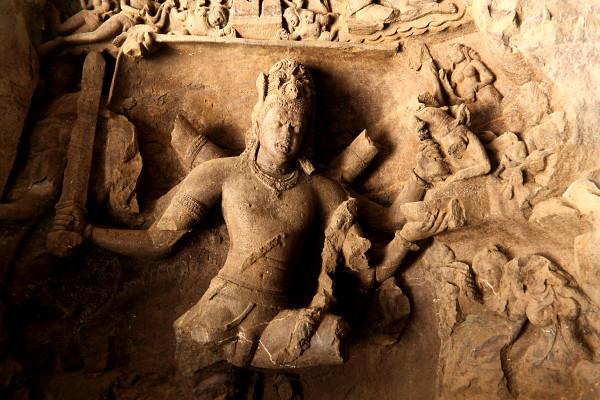
12. MARKETS OF MUMBAI
Experiencing the markets of Mumbai is an absolute must if you want to get an insight into the local life and culture, and of course if you want to go on a shopping spree. Here is a list of interesting markets you can visit during your time in Mumbai.
- Crawford Market: This marketplace is practically unending in its size and everything one could possibly imagine is sold here! From it, Crawford Market takes up a small main portion for retailers and wholesalers alike! Most tourists go here, just to experience the hustle and bustle, watch the locals in action or see the items that are on sale.
- Colaba Causeway: Perhaps the most beloved shopping area for tourists and locals alike, is the Colaba Causeway! This 700m stretch of street shops starts from the iconic Cafe Mondegar. The footpath is lined with tiny stalls selling scarfs, dresses, jewelry, and trinkets! In the tiny lanes, you will come across more shops selling handicrafts and perfumes. A place definitely not to be missed.
- Lal Baug Spice Market: A mill area not a few decades ago, right now houses innumerable spice shops located along the lanes! The lane is instantly identifiable by sacks of red chilies lined up outside the stores. The workers are buzzing around, spreading chilies on gunny bags or tarpaulin sheets to dry in the sun, filling jars of whole spices, weighing powders, and roasting whole ones in big round bottom pans!
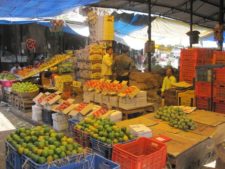
13. FOOD IN MUMBAI
When in Mumbai you can never fall short of places to dine. There are tons of options for you to choose from. However, here is our list of the best places to eat in Mumbai –
- Woodside Inn –They serve great food and a good selection of alcohol! The bar is very thoughtfully done, and gorgeous frames of colonial Mumbai adorn the walls. The atmosphere of this place is rather relaxed and chilled. Highly recommended after a day of touring the city!
- Poornima – A small eatery serving the most authentic South Indian Food! If you are here during lunchtime, you can even eat the ‘lunch thaali’ consisting of rice, vegetables, curry and flatbread. However, Idlis, Dosas, ‘Bisebelle Bhaat’ (rice with stew) are some dishes you must absolutely try here!
- Bademiya Restaurant – The Mughals form a good part of Indian history, and so did the food they brought with them. Aptly termed ‘Mughlai Cuisine’, it consists of a wide variety of ‘tandoor’ (grilled) kebabs and bread. Bademiya is a place specializing in kebabs, bread and ‘Mughlai curries!
- Britannia & Co –Located in a rather beautiful part of the city, known for its stunning architecture, this restaurant serves the famous ‘Berry Pulav’ a delicious rice dish, served with meat and sour berries. Order a side of Salli Boti (meat curry topped with fried potato sticks) and raspberry soda and end with Caramel Custard for a delicious all-rounded meal!
- Café Mondegar – Just a few blocks away from the very famous ‘Café Leopold’ this bar is at the corner of the street. The walls have fun cartoons painted and the tables are rather close together. And that is part of the fun, as it always feels like a community is drinking together. The food is not spectacular, but it is a great lively place to get a drink or two!
Read on: Find Entertaining Activities in India
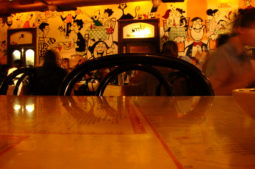
MOVING AROUND in Mumbai
In a big city like Mumbai, there are multiple ways to navigate through the city, with pros and cons for every means of transport. We suggest downloading the app m- indicator, which will help you with the schedules of trains and buses in the city, as well as the accurate fare for an auto or taxi across a certain distance.
Train
The local trains in Mumbai are one of the best, efficient and cheapest options to travel around, lovingly called the ‘lifeline’ of the city. There are three lines: The Central, Western and Harbour lines. The Central and Harbour cross over at Dadar junction if you need to make a change.
Find out which station is nearest to your destination and check that it’s on the same line as the one closest to you. Check the train schedule on m-indicator and opt for a slow train for less of a crowd and avoid travelling during peak hours (08:00-10:00 hrs and 17:00-19:00 hrs).
Tickets usually cost upwards of INR 10 all the way to INR 30-35 to get to the very edge of the city and you can purchase them at dedicated counters outside the station.
DO NOT buy them from a third party standing outside the counter, they might be counterfeit. Keep your ticket with you until you exit your destination station, you may be asked to show it on the platform again.
Uber & Ola
While Mumbai does have the famous Kali peli (black and yellow) taxis we recommend using Ola and Ubers instead to avoid scams and travel in comfort!
Rickshaws
One of the most popular and cheapest options out of Mumbai’s public transport choices are the Rickshaws (Tuk-Tuk). They’re more widespread in the suburbs, though they’re not allowed in the old part of the city in the South.
The base price here is Rs. 18 and they seat only three passengers by law. They generally run on meter however most of them refuse to do so and ask to settle on a fare before starting your trip so always make sure to haggle for the price or ALWAYS travel by meter, no matter what they insist.
Tip – You can also try to follow the route on Google Maps to ensure they aren’t taking you the long way round. Have change available, as the drivers often do not change big bills.
Spend 2 to 3 days in Mumbai and take in everything it has to offer with the help of our list! If you need our assistance in planning your trip to this beautiful region, do get in touch with us. We would be happy to help you plan a customized trip according to your need!
Learn More: Calculating the Financial Outlay for India Travel
Frequently Asked Questions
Mumbai has many fun activities you can do – visit historical sites like Gateway of India and Elephanta Caves, and visit museums and art galleries, visit Dhobi Ghat, religious places, or Chowpatty.
You can enjoy a vibrant nightlife in Mumbai in Bandra, Colaba, Juhu, and Marine Drive.
If you have two days to explore Mumbai, you can visit the Gateway of India, go shopping at Colaba Causeway and Crawford Market, explore the various cafes, check out the museums and art galleries, and watch a sunset at Marine Drive or the Chowpatty.
The food most associated with Mumbai is Vada Pav. However, Mumbai is known for a lot of delicious street food, such as Chaat, Pav Bhaji, Misal, and Bombay Sandwich. You will also find a range of scrumptious seafood and other nonvegetarian options.
helping you travel your way
Everything you need to know about India is here We have tried writing about everything you may need help with for your trip to India, If you need help in planning a trip to India Get in touch with us to to plan your trip of a life time.


